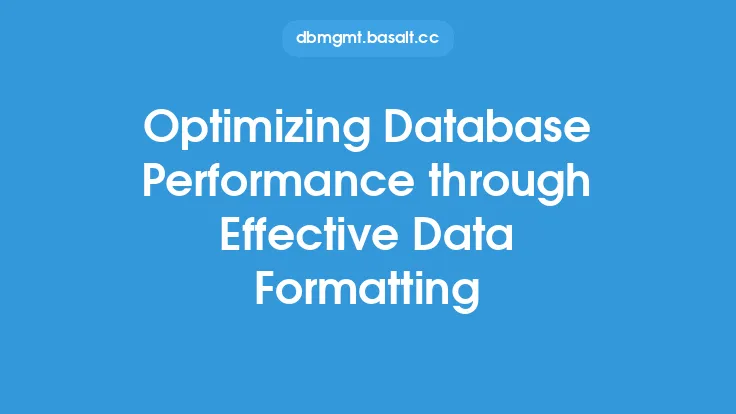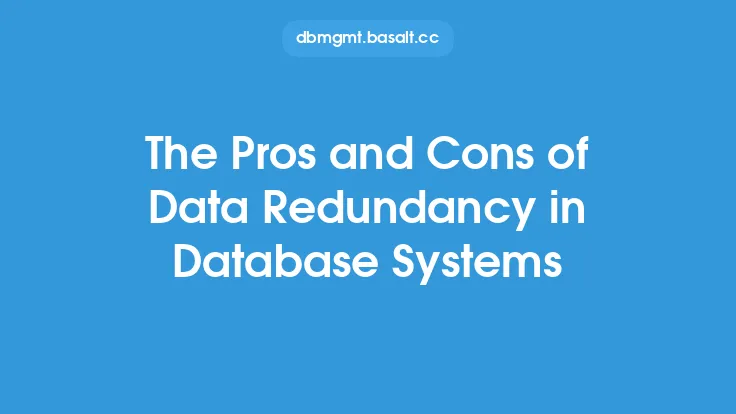Data redundancy is a fundamental concept in database design that refers to the duplication of data within a database. While data redundancy can provide several benefits, such as improved data availability and faster query performance, it can also have a significant impact on database performance. In this article, we will delve into the details of how data redundancy affects database performance and explore the technical aspects of this complex relationship.
Introduction to Data Redundancy
Data redundancy occurs when the same data is stored in multiple locations within a database. This can happen intentionally, as a result of denormalization techniques, or unintentionally, due to poor database design or data inconsistencies. Data redundancy can take many forms, including duplicate rows, redundant columns, and unnecessary data relationships. Understanding the types and causes of data redundancy is essential to grasping its impact on database performance.
The Impact of Data Redundancy on Storage
One of the most significant effects of data redundancy on database performance is the increased storage requirements. When data is duplicated, it requires more storage space, which can lead to higher costs and reduced storage efficiency. This, in turn, can affect the overall performance of the database, as larger storage requirements can result in slower query execution times and increased disk I/O. Furthermore, data redundancy can also lead to increased data fragmentation, which can further exacerbate storage-related performance issues.
Data Redundancy and Query Performance
Data redundancy can have a profound impact on query performance, both positively and negatively. On the one hand, data redundancy can improve query performance by reducing the need for joins and subqueries, which can be computationally expensive. By storing redundant data, queries can be executed more quickly, as the database does not need to perform complex operations to retrieve the required data. On the other hand, data redundancy can also lead to slower query performance, as the database must maintain data consistency across multiple locations. This can result in increased overhead, as the database must perform additional operations to ensure that redundant data is updated correctly.
The Role of Indexing in Data Redundancy
Indexing plays a critical role in data redundancy, as it can significantly impact query performance. When data is redundant, indexing can help to improve query performance by providing an efficient way to locate and retrieve the required data. However, indexing can also increase the overhead associated with maintaining data redundancy, as the database must update indexes whenever redundant data is modified. Furthermore, indexing can also lead to increased storage requirements, as indexes require additional storage space to store the indexing information.
Data Redundancy and Data Consistency
Data consistency is a critical aspect of database design, and data redundancy can have a significant impact on data consistency. When data is redundant, it can be challenging to maintain data consistency, as changes to one copy of the data must be propagated to all other copies. This can lead to data inconsistencies, which can have serious consequences, such as data corruption or incorrect query results. To mitigate these risks, databases often employ techniques such as transactional logging and locking mechanisms to ensure that data consistency is maintained.
The Impact of Data Redundancy on Database Maintenance
Data redundancy can also have a significant impact on database maintenance, as it can increase the complexity and overhead associated with maintaining the database. When data is redundant, database administrators must perform additional tasks, such as data synchronization and consistency checks, to ensure that the data remains consistent and accurate. Furthermore, data redundancy can also increase the risk of data errors, which can be time-consuming and costly to correct.
Best Practices for Managing Data Redundancy
To minimize the negative impacts of data redundancy on database performance, it is essential to follow best practices for managing data redundancy. These include:
- Implementing data normalization techniques to minimize data redundancy
- Using indexing and caching to improve query performance
- Implementing data consistency mechanisms, such as transactional logging and locking
- Regularly monitoring and maintaining the database to ensure data consistency and accuracy
- Using data redundancy intentionally, as a result of denormalization techniques, to improve query performance
Conclusion
In conclusion, data redundancy can have a significant impact on database performance, affecting storage requirements, query performance, and data consistency. While data redundancy can provide several benefits, such as improved data availability and faster query performance, it can also increase the complexity and overhead associated with maintaining the database. By understanding the causes and effects of data redundancy and following best practices for managing data redundancy, database administrators can minimize the negative impacts of data redundancy and optimize database performance.





